This Easy Homemade Rye Bread made with caraway seeds tastes delicious and is a wonderful, wholesome change for sandwiches, toast, or just served with butter along with a meal.
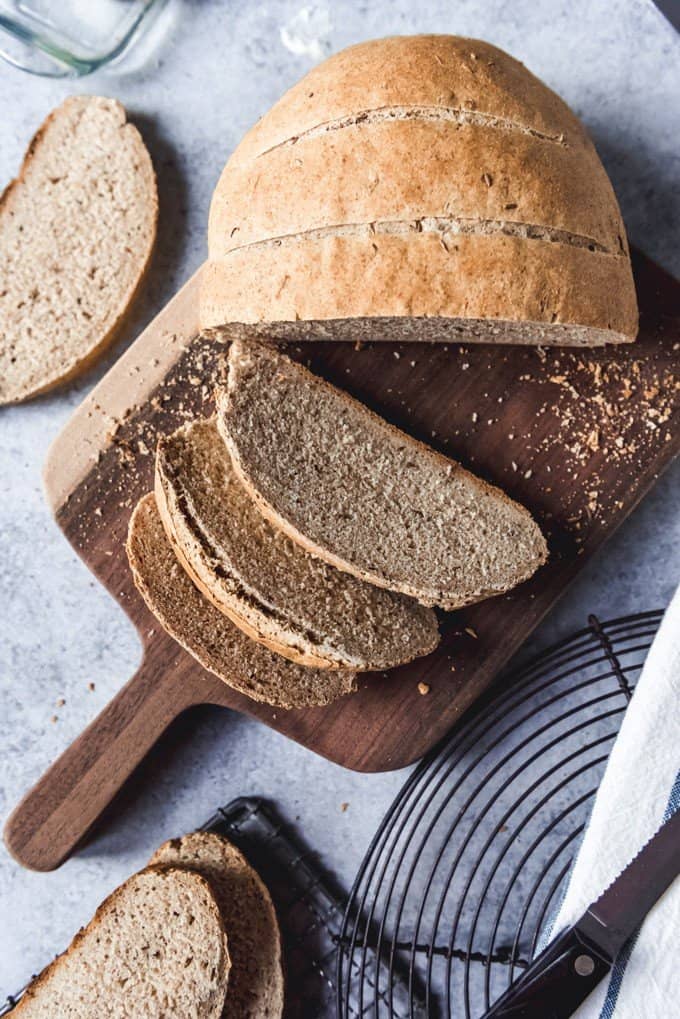
There is nothing like loaves of homemade bread coming out of the oven. Some of our other favorites are Sweet Molasses Brown Bread, Easy Rosemary Focaccia Bread, and Amish White Bread.
You’ll love this Light Rye Bread
I am a big-time bread fan, whether it’s a sweet molasses brown bread, a classic loaf of french bread, or a strong caraway rye bread. Bread is one of my favorite foods.
Since I had never made rye bread before, I looked to a lot of resources online to get an idea for how to approach it and what kind of rye bread would work best for my family.
I found this post from the King Arthur Flour site to be super helpful in describing different types of rye bread, if you want to try something a little darker or different than the light sandwich rye that I am sharing today.
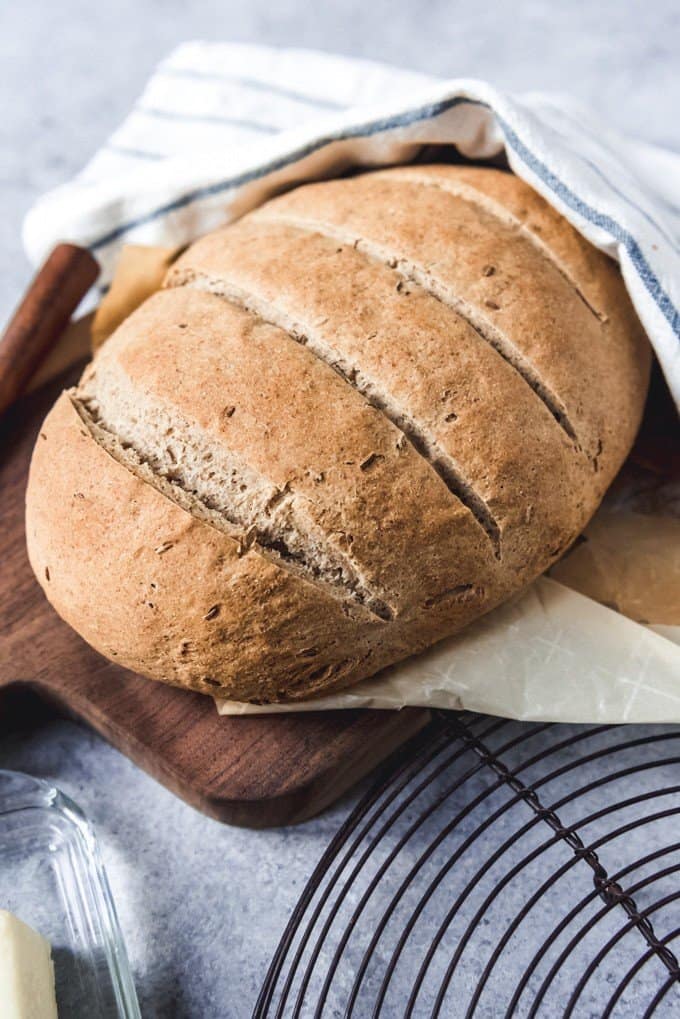
What is Rye Bread?
Rye bread can run the gamut from a fruit-and-nut studded loaf to a classic sourdough rye, to the dark, dense pumpernickel (another of my favorite breads that I want to make one of these days!) which is actually a type of rye bread.
And then there is the light, caraway sandwich variety, which is the kind I decided to make.
I wanted to share a simple rye bread recipe that would taste as good with butter and jam at breakfast as with cheese and lunchmeat for a sandwich later in the day.
The reason caraway seeds matter in this bread is that rye bread actually has a fairly mild flavor on its own.
So kneading seeds like caraway, fennel, or anise into the dough or sprinkling seed mixes like Trader Joe’s Everything Bagel Topping on top will give distinctive taste to a loaf of rye bread.
Caraway seeds are what are in the rye bread at my favorite German restaurant, so that’s what I went with this time around.
What does Rye Bread taste like?
Rye bread has a distinct and unique flavor profile compared to other types of bread, like wheat or white bread. It’s characterized by its earthy, slightly tangy, and nutty taste. The taste of rye bread can vary depending on the type of rye used, the proportion of rye to other grains (such as wheat), and the baking process. Rye bread can exhibit a mild tanginess, similar to sourdough bread. This tanginess is usually a result of the fermentation process, where natural yeasts and bacteria break down the starches and produce lactic acid. Also, rye bread is typically denser and heavier than traditional white bread due to the lower gluten content of rye flour. This density can contribute to a satisfying chewiness.
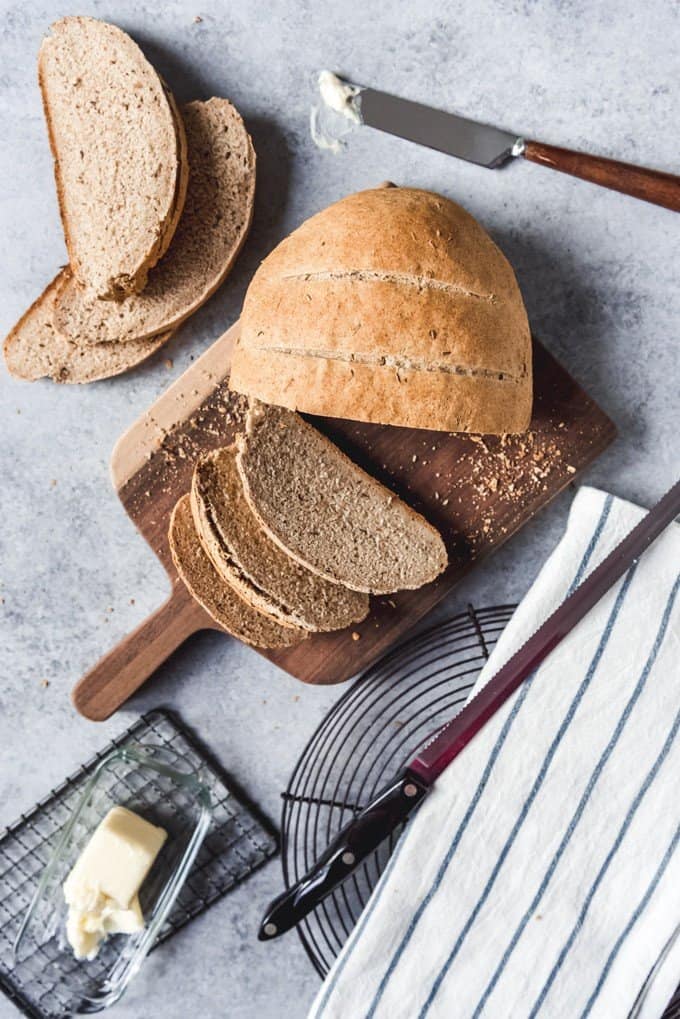
My friend Jenni from The Gingered Whisk and I have been doing a series for the past year where we look at old recipes from a specific time period and recreate them in our home kitchens to feed to our families. Sometimes we try to keep the recipes as close to their historical roots as possible, and other times we tweak them to fit our modern palates.
My first post in the series was last October when I shared a beef steak pie recipe from the Salem Witch Trial period in colonial America.
For this installment, we decided to attempt foods from the Middle Ages, which turned out to be pretty challenging for me. Medieval food recipes are pretty out there, and the more I researched about food in medieval times, the more I realized that I needed to distinguish between the food of the rich and the food of the poor because what you ate was very strongly influenced by where you were in society.
In the Middle Ages, there was a well-defined hierarchy to the social structure with royalty at the top, followed by nobles, then knights, then the clergy, then tradesmen and peasants. You were born into a class of people and generally stayed there your entire life, with very little opportunity for advancement.
I ended up choosing a food that better represents that poor peasant class (even though this homemade rye bread recipe is actually still much better than what peasants would have had access to since I used wheat flour along with rye flour), and Jenni made Sheet Pan Spiced Pork Meatballs in Almond Sauce with Roasted Vegetables, which is based on an actual medieval recipe and represents the food of the higher classes who had access to much more protein and many more spices to vary their diet.
I have seen recipes very similar to the one I am sharing described alternately as Jewish, Polish or German. I didn’t do any in-depth research into the differences of each, but from a cursory look at quite a few different recipes, I would say this is closer to the Jewish or Polish versions.
Although it makes sense that this would be classified German as well because it tastes very much like the bread served at our favorite authentic German restaurant in San Francisco.
When were the Middle Ages?
The Middle Ages, also known as the Medieval Period in Europe, lasted from the 5th to the 15th centuries. There are actually three different periods known as the Early, High, and Late Middle Ages, each with their own distinctions, but we didn’t decide to focus on any one period when selecting our recipes.
It’s a fascinating, confusing time in history though, with changes like the rise of kingdoms and the social structures that we typically think of when looking back at the middle ages. Knights and nobles controlled lands that were rented to peasants who were organized into small villages.
There was climate change known as the medieval warm period that increased the ability to grow crops, followed by plague and famine and war. It must have been a tough time to be alive.
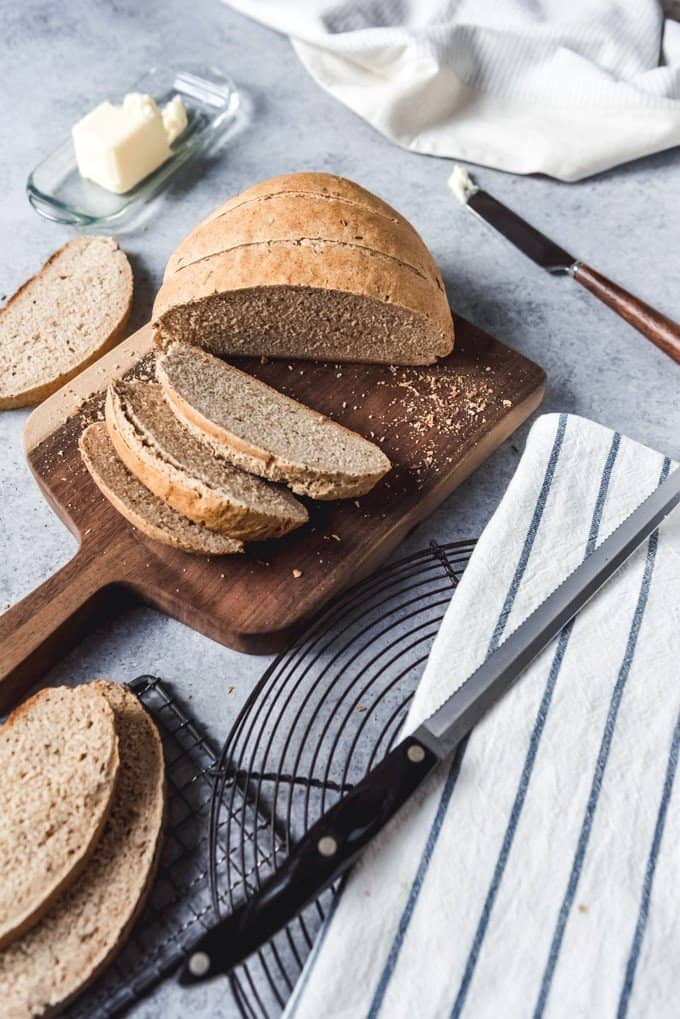
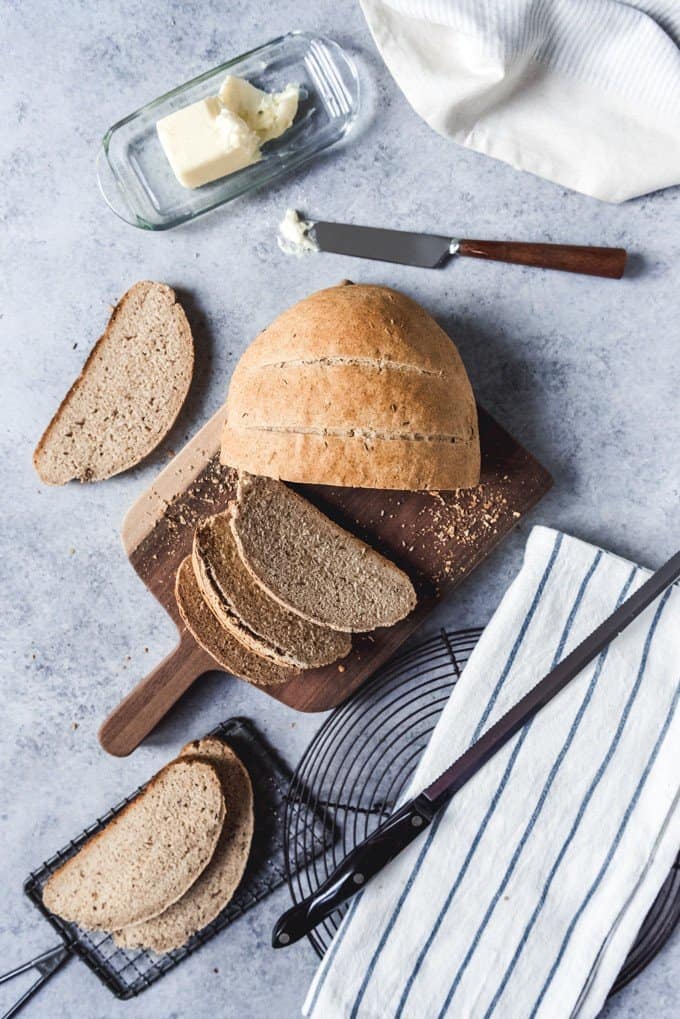
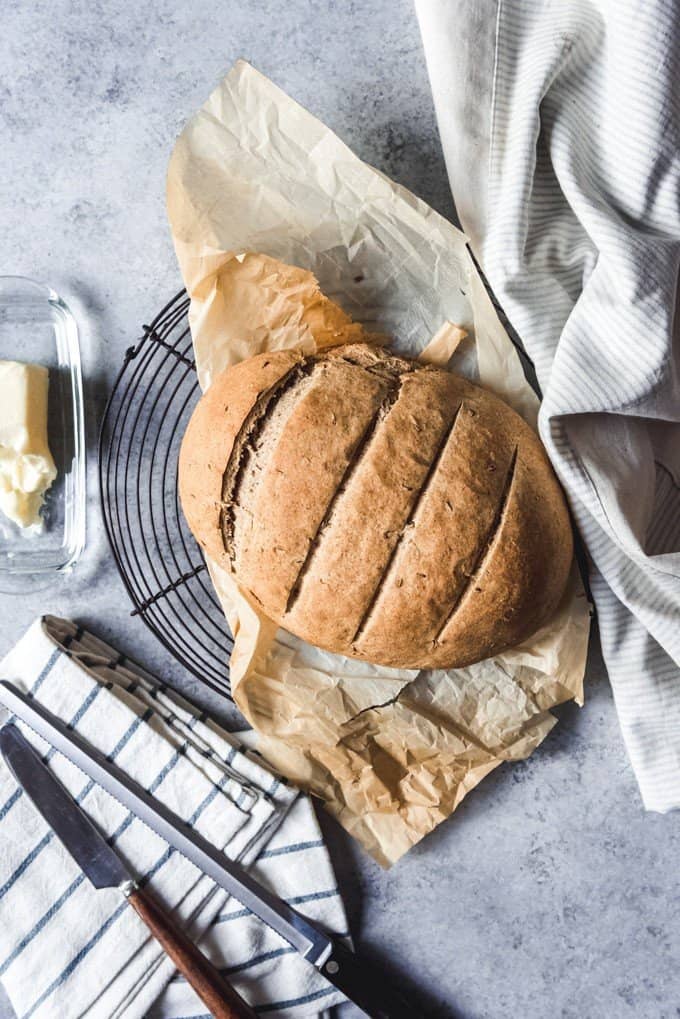
Is Light Rye Bread Good for You?
I’m not a nutritionist, but I can tell you that rye bread is lower in gluten content than other, all wheat flour breads. This version still has wheat in it, so it isn’t gluten-free, but it is lower on the glycemic index so it is less likely to spike your blood sugars than all-white bread.
Rye bread also has higher fiber content than white bread. And since this is homemade bread, it’s free from preservatives and additives and all that other stuff.
Plus, I don’t know, it just tastes like it is doing good things for you. And that has got to count for something!
Rye Bread Ingredients
- Flour – I like to use a combination of bread flour, whole wheat flour, and of course rye flour in my rye bread.
- Honey – For just a hint of sweetness and to help the yeast get going.
- Active dry yeast – If using instant yeast, you can skip proofing the yeast and go straight to mixing the other ingredients together.
- Warm water – This shouldn’t be too hot or too cold or the yeast won’t proof. It should be around 110-115°F.
- Milk – A little whole milk adds depth of flavor to the bread loaf, but plain water can be used instead.
- Salt – So the bread doesn’t turn out bland.
- Vegetable oil – A little fat helps give the bread a moist crumb.
- Caraway seeds – These are for even more flavor and they are delicious, but you can omit them if you don’t care for them.
How to make Rye Bread
I think it’s clear by now that my recipe for homemade rye bread differs from authentic Medieval bread, especially the kind that would have been eaten by the lower classes, for a few reasons.
One of those reasons is that I use yeast to leaven the bread and make a soft loaf that is delicious to eat sliced and spread with butter.
I also combined three different types of flour – rye flour, whole wheat flour, and bread flour, to get a softer, more tender bread with more “lift” than 100% rye bread.
But even with these changes, this bread is certainly different from the standard loaves you might get at the store. And it’s a great way to introduce your family to new flavors that are a little more unusual than what they might be used to.
Making this homemade rye bread uses the same techniques as making any other loaf of bread. Start by proofing your yeast in some warm water with a little honey.
Then it’s just a matter of kneading in a little salt with the different types of flour and the caraway seeds.
Incidentally, if you are wondering what else to use caraway seeds for so they aren’t just sitting in your cupboard for making loaves of rye bread, try this rotkohl recipe or sauerkraut and sausages with apples that is one of our family’s favorite dinners during cold weather months.
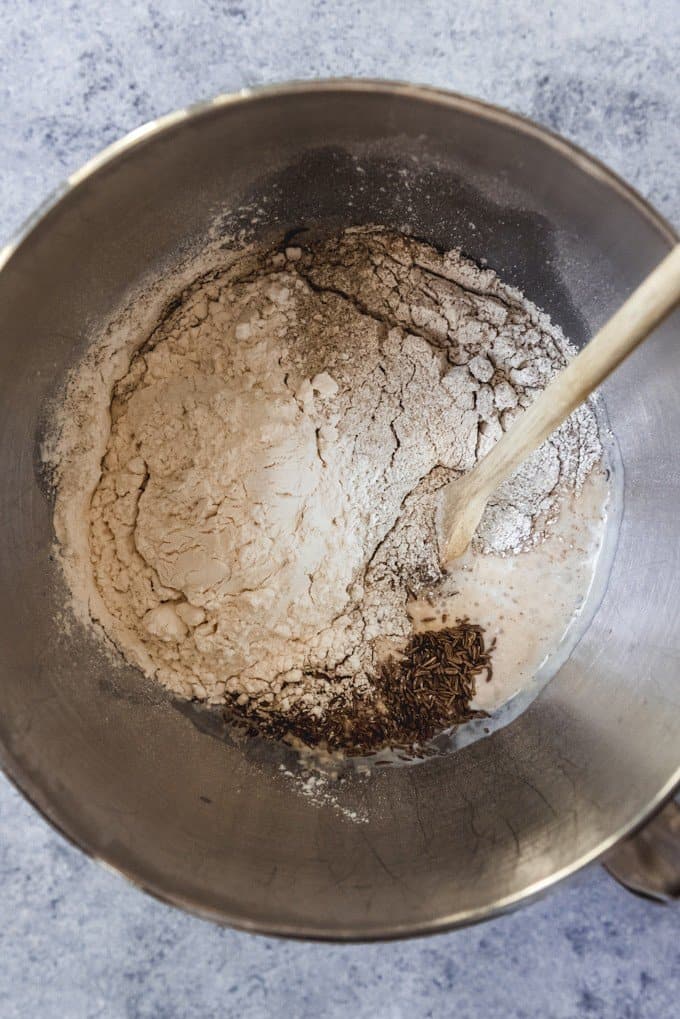
The loaf might take a bit longer to rise than most loaves since rye has less gluten in it, but the shaping and baking are all the same.
You could bake this homemade rye bread in a bread pan for a higher “sandwich” looking bread, or just place it on a baking sheet on a piece of parchment paper for a more rustic, artisan looking loaf like you see in these pictures.
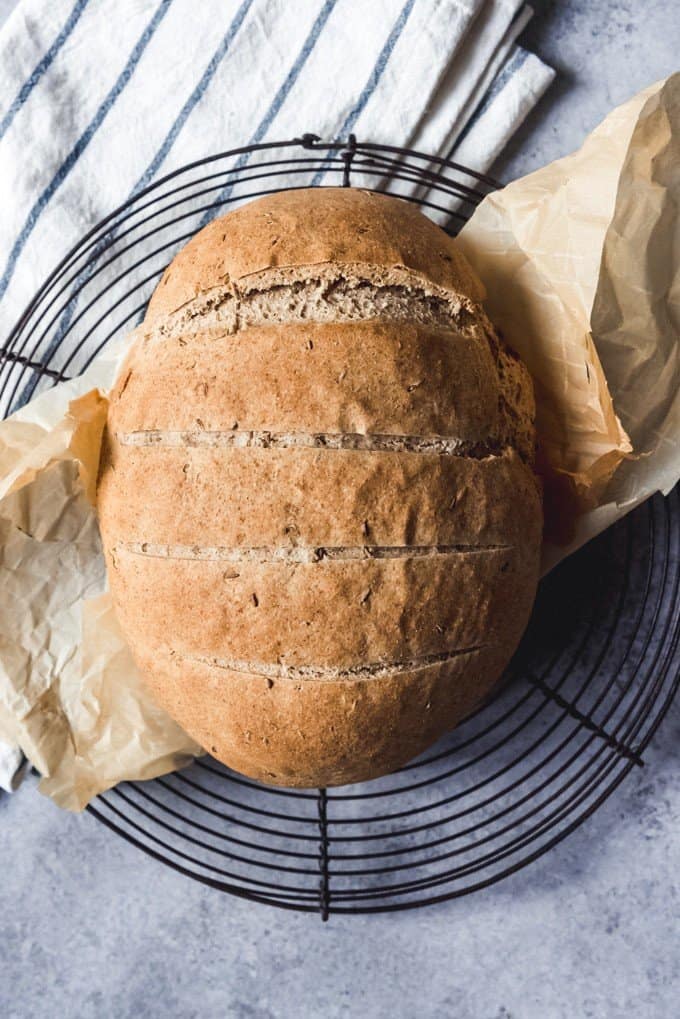
Then slice and enjoy! Do you like to make bread at home? Let me know what kind in the comments below!
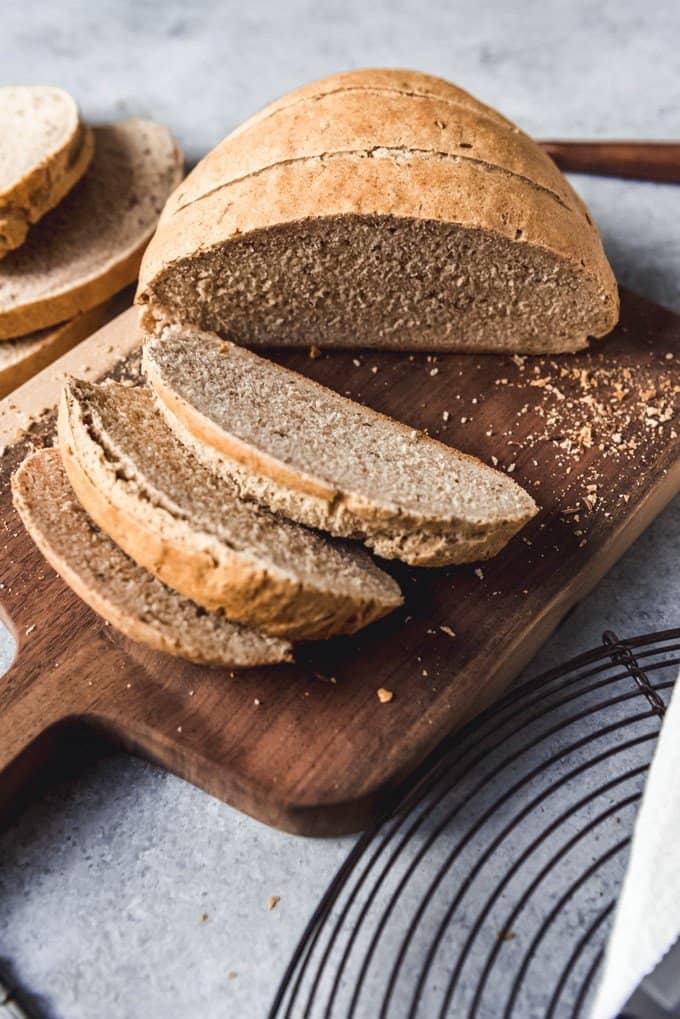
Ways to Serve Light Rye Bread
Light rye bread, with its slightly milder flavor compared to dark or whole grain rye bread, can be versatile and delicious in a lot of ways! Try using it for sandwiches, toast, bruschetta, French toast, panini, or alongside soup.
How to Store This Easy Rye Bread Recipe
Once completely cooled, wrap your loaves of rye bread in plastic wrap and store in an airtight container or bag for up to 3-4 days. Like most homemade breads, it’s best when fresh the day it is made, but you can use stale rye bread to make croutons, add to stuffing recipes, or even make French toast!
Freezing Homemade Rye Bread
To freeze a loaf of homemade rye bread, simply let it cool completely, then wrap it well in plastic wrap and store it in a freezer safe ziploc bag for up to 2 months. Thaw on the counter for a couple of hours before slicing and enjoying.
More Like This Light Rye Bread Recipe
More Favorites from House of Nash Eats
Did you make this recipe?
Let me know what you thought with a comment and rating below. You can also take a picture and tag me on Instagram @houseofnasheats or share it on the Pinterest pin so I can see.
Rye Bread Recipe (Easy!)
Ingredients
- 1/2 cup warm water (about 110-115°F)
- 1 Tablespoon honey
- 1 1/2 Tablespoons active dry yeast
- 1 cup whole milk, room temperature
- 2 teaspoons table salt
- 2 Tablespoons vegetable oil
- 1 to 1 1/2 cups bread flour
- 1 to 1 1/2 cups whole wheat flour
- 1 1/2 cups dark rye flour
- 2 Tablespoons whole caraway seeds
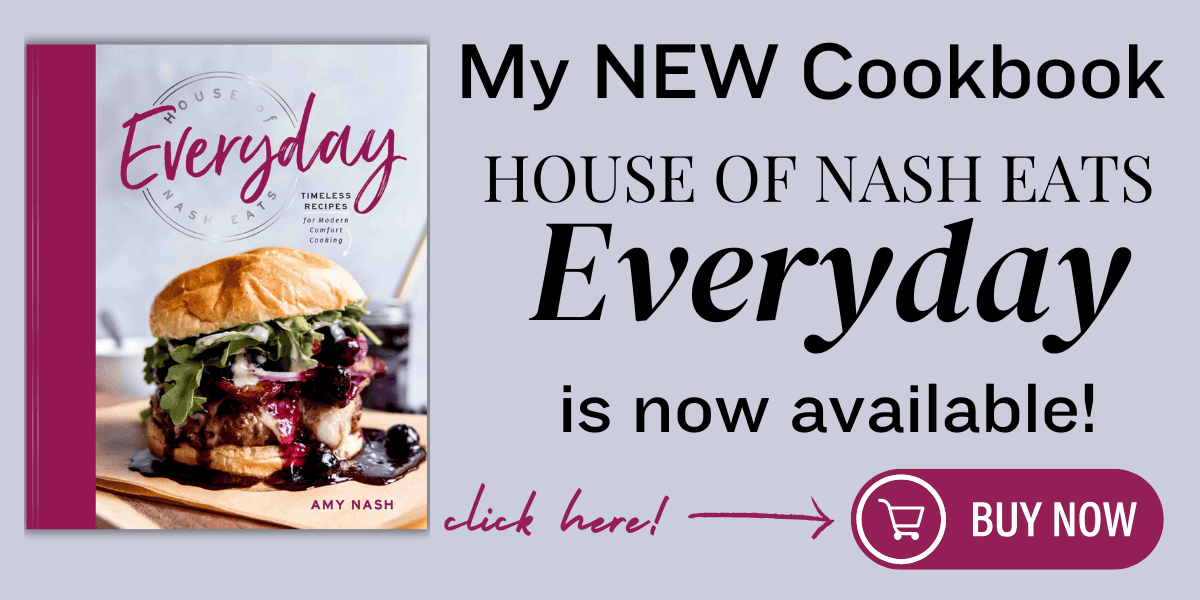
Instructions
- In the bowl of an electric stand mixer fitted with a hook attachment, combine the warm water and honey, then sprinkle the yeast on top of the water and let it proof for 5 minutes.½ cup warm water, 1 Tablespoon honey, 1 ½ Tablespoons active dry yeast
- Add the milk, salt, oil, bread flour, whole wheat flour, rye flour, and caraway seeds to the yeast mixture and knead on medium-low speed until the dough starts to come together. I always start with the lower amount of bread and whole wheat flours listed, then add more as needed.1 cup whole milk,, 2 teaspoons table salt, 2 Tablespoons vegetable oil, 1 to 1 ½ cups bread flour, 1 to 1 ½ cups whole wheat flour, 1 ½ cups dark rye flour, 2 Tablespoons whole caraway seeds
- Increase the speed to medium-high and knead for 8-10 minutes until the dough is smooth and no longer sticking to the sides of the bowl.
- Place the dough in a large, lightly oiled bowl and cover with a towel. Let the dough rise in a warm place until doubled in size, about 1 ½ hours.
- When the dough has risen, punch it down and transfer to a clean work surface. Let it rest for 5 minutes, then shape it into a loaf and transfer to a baking sheet lined with parchment paper. Cover with a towel and let rise for another hour until doubled in size again.
- When the dough is close to being doubled in size, preheat the oven to 425°F. Slash the dough with a sharp knife to create gashes on top. Open the oven and throw a few ice cubes on the bottom when you place the bread in to bake. This will create steam that will make for a great crust to the bread. Bake for 30 minutes until crusty and golden brown.
Notes
- Rye flour has a lower gluten content than regular flour, so it will typically take a little longer to rise than other loaves.
- I had a previous omission in the recipe where I had typed in 3 cups of bread flour and 1 ½ cups of the rye flour. I have since changed it to 1 ½ cups of bread flour, 1 ½ cups of whole wheat flour, and 1 ½ cups of rye flour. I find that both ways work, but the version with the whole wheat is heartier.

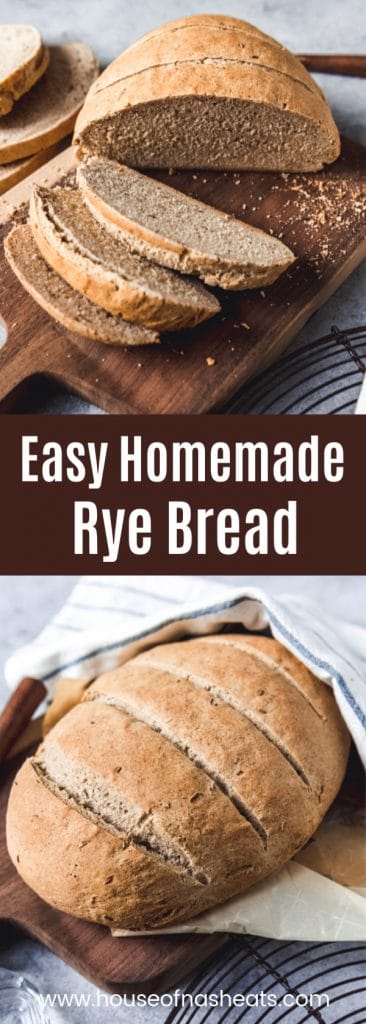
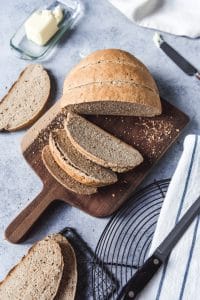





The bread turned out really well, but the crust was burnt on top. Any advice?
If the top is getting too dark, try loosely covering the loaf with aluminum foil for the last 20 minutes or so of baking. It could be an oven issue also and possibly moving the oven rack down one level could help.
Came out dense like a brick, unfortunately.
Came out very good. I didn’t have caraway seeds, but it was still delicious. No bricks here!
I’m so glad to hear it!
I forgot to put the stars, I think.
Lol, thank you! BTW we call my mom “Grandma Cece”!
My husband absolutely LOVES Rueben’s. The recipe was perfect!
Great! Good to hear!
January 18 2025
I am a fan of bread making, a lost Art. I have used the aTasahrà Bread making book and recipes since it’s inception in the 1970’s.
You have developed a well balanced rye bread recipe. I substituted white rice flour for 2hite flour and substituted dill seed from my garden.
Excellent well portioned bread recipe and flours. I also did a white egg wash, for a nice crust.
Great! Thank you so much! You sound like you are quite the bread making pro!
Very easy recipe to make. Made it for the first time today. It is so delicious!♥️
Thank you so much BJ!
Very dense. I think I’ll try using less wheat flour and give it one more try. Hopefully this will help.